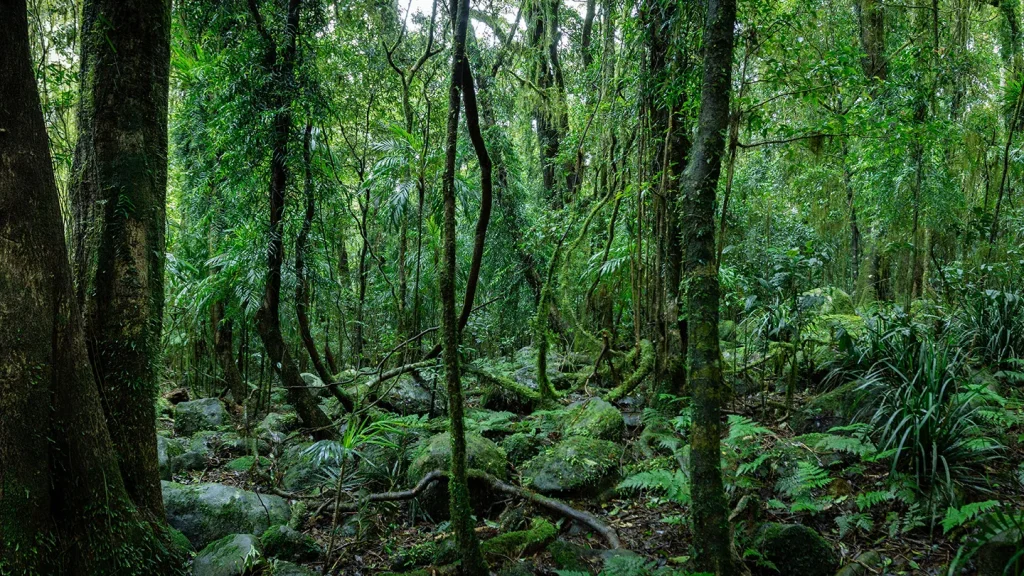Australia’s Tropical Forests Signal Global Climate Warning
In a significant climate development, Australia’s tropical forests have become the first in the world to reach a troubling milestone: they now emit more carbon than they absorb. This alarming shift, documented in a recent study published in Nature, sounds a powerful warning bell for tropical forests globally as world leaders prepare to gather in Belém, Brazil for the 30th United Nations Climate Change Conference (COP30) in November.
Researchers from Western Sydney University, led by ecophysiologist Hannah Carle, conducted an extensive analysis spanning nearly five decades from 1971 to 2019. Their findings reveal a disturbing trend: since approximately the year 2000, the woody biomass of Australia’s rainforests—the essential framework of trunks and branches that store carbon—has been steadily diminishing. This decline stems primarily from increased tree mortality driven by human-caused climate change, including rising temperatures, prolonged droughts, and more destructive tropical cyclones. As trees die, the carbon they once stored is released back into the atmosphere, exacerbating climate change in a dangerous feedback loop.
Previous climate models had suggested that increased atmospheric carbon dioxide might stimulate plant growth, potentially mitigating forest decline. However, this research uncovered a surprising contradiction—the additional carbon dioxide did not significantly boost forest growth as expected. The researchers hypothesize that this limited response may be due to nutrient constraints, particularly phosphorus deficiency in forest soils. This finding highlights the complex interplay of factors affecting forest health and suggests that nutrient limitations must be considered when projecting future forest trajectories and their impact on climate change.
“Our finding stresses that ambitious actions should be taken to slow down climate change, including in relation to protecting tropical forests,” emphasizes study co-author David Bauman, a plant ecologist at the French National Research Institute for Sustainable Development. The upcoming COP30 conference represents a crucial opportunity to address these concerns, particularly regarding the Amazon rainforest, which is approaching its own tipping point. Covering an area nearly as large as the continental United States, the Amazon currently shoulders one-fourth of terrestrial carbon dioxide absorption. However, it faces unprecedented challenges, including its worst-ever drought in 2024 and approximately 17% deforestation to date. Scientists warn that without immediate intervention, the combined pressures of climate change, deforestation, biodiversity loss, water stress, and extreme weather could trigger extensive Amazon dieback as soon as 2035.
The situation extends beyond Australia and the Amazon to other major tropical forests worldwide. While comprehensive long-term monitoring data remains insufficient, existing studies indicate declining carbon storage capacity in tropical forests across Africa’s Congo Basin and Southeast Asia. Southeast Asian forests face particular threats from fragmentation due to urban development, agriculture, and infrastructure projects. African forests, while showing later signs of stress than other regions, began exhibiting increased tree mortality around 2010. Forest ecologist Wannes Hubau of Ghent University describes the situation as “quite alarming,” noting that “African tropical forests seem to be the last man standing.”
Despite nearly 140 nations signing a declaration at COP26 in Glasgow to halt and reverse forest loss and land degradation by 2030, progress has fallen dramatically short of commitments. According to a recent UN Environment Programme report, approximately 291 million hectares of the world’s 1.6 billion hectares of tropical forest are currently at high risk—including forests most vital to human wellbeing through food provision, rainfall regulation, pollution filtering, and natural hazard protection. The report emphasizes that protecting these forests will require global financial investments to triple to $300 billion by 2030 and increase sixfold to $498 billion by 2050, supporting sustainable agriculture, deforestation-free supply chains, and enhanced regulation.
“The Amazon forest carbon sink is passing a tipping point as we speak,” warns Hubau. “It shows that our planet’s natural climate buffers are starting to meet their limits.” The message is clear: all tropical forests require increased protection, even those no longer functioning as carbon sinks. These ecosystems represent massive carbon reservoirs built over centuries or millennia. Without immediate protection, they risk becoming what Hubau describes as a “bomb” of additional CO2 released into our already warming atmosphere.


